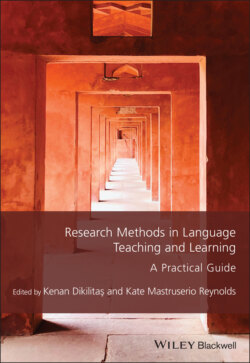Читать книгу Research Methods in Language Teaching and Learning - Группа авторов - Страница 55
Moving Towards Implementing Grounded Theory
ОглавлениеIn qualitative research studies, the subjective involvement of researchers is acknowledged, because they are seen as a natural part of research. They make important decisions and interpretations throughout the research and these are inevitably informed by their subjective viewpoints. This is considered to be a strength of qualitative research. However, with regard to data analysis, relying on researchers’ subjective intuition is questionable, because this might lead to making wrong interpretations. Miles and Huberman (1994) do not consider this to be a strength of qualitative research and assert that qualitative data analysis should be systematic and methodology-driven.
One of the significant methodologies for qualitative research is grounded theory. Strauss and Corbin (1998) describe grounded theory as a “general methodology for developing theory that is grounded in data systematically gathered and analyzed” (p. 158). It proposes carefully planned steps of developing a theory (Crotty, 1998), and hence, it is “a systematic process of developing a theoretical hypothesis from descriptive data” (Perry, 2005, p. 75).
Glaser (2007) posits that grounded theory is used interchangeably with qualitative content analysis in many research studies. However, grounded theory is more than just qualitative analysis. Glaser and Holton (2004) identified several differences between grounded theory and qualitative descriptive analysis in a detailed way. Accordingly, grounded theory analysis is not descriptive: it does not yield an in-depth understanding of the phenomena but “produces a substantive, conceptual theory with general implications” (p. xx). This allows the researcher to bridge the gap between theory and practice, because relationships between concepts of data are identified without any preconceived categories or codes (Grix, 2004). As a result, from a grounded theory perspective, qualitative data is not seen as an objective that researchers want to achieve to understand a situation, but rather as evidence which leads researchers to generate a theory.
In the literature, there are different methodological alternatives that guide researchers in implementing grounded theory. Considering that qualitative research is context-dependent, each research may require following different processes. For that reason, researchers can adapt grounded theory methodologies to their research contexts. The procedures we followed in this research are in line with the essential grounded theory methods proposed by Birks and Mills (2015).
In this research, I coded and categorized the qualitative data to detect important issues relevant to my research questions. The data collection and analysis processes were iterative, in that I analyzed the questionnaire data before conducting follow-up interviews, so that I could ask interviewees to elaborate on some significant data collected through the questionnaires. In addition, I analyzed the data collected from student participants before conducting interviews with the teacher, so that we were able to exchange ideas on the data provided by the students.
I recorded my personal views throughout the research using the field notes that I made during observations. This enabled me to recall issues that I found significant in different phases of the research and to use these to collect further data and generate a theory. With regard to theoretical sampling, I used purposive sampling and collected data from students with different characteristics, so that I could understand the situation from varied points of view. Throughout the study, I constantly compared different types of data (i.e., qualitative and quantitative) collected through different data collection methods (i.e., observation, interview, and questionnaire). This allowed me to check whether these findings confirmed each other and to identify core categories and sub-categories.
Regarding theoretical sensitivity, I used my knowledge of student negotiation and my memos. This was also useful for generating a further understanding of the categories that emerged from the data. In intermediate coding, I attempted to make connections between categories. For example, participants reported that they learned how to use circumlocution as a communication strategy. This category was then linked with “fluency”, because later on participants reported that using circumlocution helped them speak more fluently. These processes led to the identification of a core category, which was increased classroom participation. In explaining our core category, increased classroom participation, we referred to relevant categories and the literature based on these categories. These procedures enabled me to generate theoretical hypotheses.
